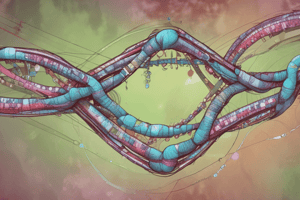Podcast
Questions and Answers
What is the main function of alternative splicing?
What is the main function of alternative splicing?
- To increase the number of genes in the genome
- To create different mRNA transcripts from a single primary RNA transcript (correct)
- To create different DNA sequences from a single gene
- To change the frequency of mutagenesis
What is the role of snRNPs in alternative splicing?
What is the role of snRNPs in alternative splicing?
- They are involved in the processing and splicing of primary RNA transcripts. (correct)
- They code for the amino acid sequence of proteins.
- They are responsible for the transportation of mRNA from the nucleus to the cytoplasm.
- They act as catalysts for DNA replication.
Which of the following is NOT a reason why a three-base codon is necessary to code for all 20 amino acids?
Which of the following is NOT a reason why a three-base codon is necessary to code for all 20 amino acids?
- A three-base codon provides sufficient combinations to code for all 20 amino acids and more.
- A two-base codon could only code for 16 amino acids.
- A three-base codon is necessary to regulate the frequency of mutagenesis. (correct)
- A one-base codon could only code for four amino acids.
How does alternative splicing contribute to cancer cell development?
How does alternative splicing contribute to cancer cell development?
Which of the following is a characteristic of the genetic code?
Which of the following is a characteristic of the genetic code?
What is the primary function of transfer RNA (tRNA) during translation?
What is the primary function of transfer RNA (tRNA) during translation?
The "wobble hypothesis" refers to:
The "wobble hypothesis" refers to:
Which of the following statements accurately describes the relationship between translation and transcription in prokaryotes?
Which of the following statements accurately describes the relationship between translation and transcription in prokaryotes?
What is the key factor determining the final three-dimensional structure of a protein?
What is the key factor determining the final three-dimensional structure of a protein?
Why is redundancy in the genetic code important?
Why is redundancy in the genetic code important?
What is the main function of telomerase?
What is the main function of telomerase?
Why is telomerase sometimes referred to as the 'fountain of youth'?
Why is telomerase sometimes referred to as the 'fountain of youth'?
What is the primary reason for the use of AT-rich sequences in promoter regions?
What is the primary reason for the use of AT-rich sequences in promoter regions?
What is the main difference between DNA and RNA?
What is the main difference between DNA and RNA?
What is the main purpose of RT-PCR?
What is the main purpose of RT-PCR?
What is the main role of RNA polymerase in transcription?
What is the main role of RNA polymerase in transcription?
How does the human genome project demonstrate the application of DNA replication knowledge?
How does the human genome project demonstrate the application of DNA replication knowledge?
During translation, what is the primary role of tRNA?
During translation, what is the primary role of tRNA?
What is the significance of the 'wobble' phenomenon in translation?
What is the significance of the 'wobble' phenomenon in translation?
What is the role of the 'A' site in a ribosome?
What is the role of the 'A' site in a ribosome?
Which of the following is NOT a factor involved in protein folding?
Which of the following is NOT a factor involved in protein folding?
What is the primary reason why a change in a DNA sequence does not immediately lead to a mutation?
What is the primary reason why a change in a DNA sequence does not immediately lead to a mutation?
What is the difference between a primary structure and a secondary protein structure?
What is the difference between a primary structure and a secondary protein structure?
Which DNA repair mechanism involves the removal of a mutated DNA segment and its replacement with a correct sequence?
Which DNA repair mechanism involves the removal of a mutated DNA segment and its replacement with a correct sequence?
Which of the following bonds contributes significantly to the tertiary structure of a protein?
Which of the following bonds contributes significantly to the tertiary structure of a protein?
Which type of protein structure is characterized by interactions between multiple polypeptide chains?
Which type of protein structure is characterized by interactions between multiple polypeptide chains?
What distinguishes chromosomal insertions/deletions from frame shift mutations?
What distinguishes chromosomal insertions/deletions from frame shift mutations?
Which chromosomal mutation involves a segment of the chromosome breaking off and attaching to a different chromosome?
Which chromosomal mutation involves a segment of the chromosome breaking off and attaching to a different chromosome?
What is the significance of the CCA moiety at the 3' end of a tRNA molecule?
What is the significance of the CCA moiety at the 3' end of a tRNA molecule?
What is the significance of the Philadelphia chromosome?
What is the significance of the Philadelphia chromosome?
Which of the following is an example of a secondary protein structure?
Which of the following is an example of a secondary protein structure?
What is the primary characteristic of transposable elements (TEs)?
What is the primary characteristic of transposable elements (TEs)?
Why is it important to ensure that the tRNA molecule in the host cell has the appropriate anticodon for a particular protein being synthesized?
Why is it important to ensure that the tRNA molecule in the host cell has the appropriate anticodon for a particular protein being synthesized?
How does proofreading contribute to DNA stability?
How does proofreading contribute to DNA stability?
Which of the following is NOT a mechanism involved in DNA repair?
Which of the following is NOT a mechanism involved in DNA repair?
In the context of bacterial gene regulation, what does 'repressible' mean?
In the context of bacterial gene regulation, what does 'repressible' mean?
Which of the following is NOT a characteristic of an operon?
Which of the following is NOT a characteristic of an operon?
How does the tryptophan (Trp) operon function?
How does the tryptophan (Trp) operon function?
The lac operon is an example of inducible gene regulation. What does this mean?
The lac operon is an example of inducible gene regulation. What does this mean?
Which of the following is NOT a gene encoded by the lac operon?
Which of the following is NOT a gene encoded by the lac operon?
What is the primary advantage of bacteria having operons?
What is the primary advantage of bacteria having operons?
What is the primary function of the 'permease' protein encoded by the lac operon?
What is the primary function of the 'permease' protein encoded by the lac operon?
Why is lactose metabolism considered a catabolic pathway?
Why is lactose metabolism considered a catabolic pathway?
Flashcards
Alternative Splicing
Alternative Splicing
The process where a single primary RNA transcript can be processed to produce different mature mRNA transcripts, leading to various proteins.
snRNPs
snRNPs
Small nuclear ribonucleoproteins involved in the splicing of pre-mRNA to form mature mRNA.
Codon
Codon
A sequence of three nucleotides that together form a unit of genetic code corresponding to a specific amino acid.
Genetic Code
Genetic Code
Signup and view all the flashcards
Start Codon
Start Codon
Signup and view all the flashcards
Telomerase
Telomerase
Signup and view all the flashcards
Ribonucleoprotein
Ribonucleoprotein
Signup and view all the flashcards
Complementary RNA sequence
Complementary RNA sequence
Signup and view all the flashcards
Exogenous telomerase
Exogenous telomerase
Signup and view all the flashcards
PCR (Polymerase Chain Reaction)
PCR (Polymerase Chain Reaction)
Signup and view all the flashcards
RT-PCR
RT-PCR
Signup and view all the flashcards
Transcription in eukaryotes
Transcription in eukaryotes
Signup and view all the flashcards
RNA modifications
RNA modifications
Signup and view all the flashcards
Wobble hypothesis
Wobble hypothesis
Signup and view all the flashcards
Translation
Translation
Signup and view all the flashcards
Essential amino acids
Essential amino acids
Signup and view all the flashcards
Non-essential amino acids
Non-essential amino acids
Signup and view all the flashcards
tRNA (transfer RNA)
tRNA (transfer RNA)
Signup and view all the flashcards
Operons
Operons
Signup and view all the flashcards
Polycistronic mRNA
Polycistronic mRNA
Signup and view all the flashcards
Anabolism
Anabolism
Signup and view all the flashcards
Trp Operon
Trp Operon
Signup and view all the flashcards
Catabolism
Catabolism
Signup and view all the flashcards
Lac Operon
Lac Operon
Signup and view all the flashcards
Repressor protein
Repressor protein
Signup and view all the flashcards
tRNA
tRNA
Signup and view all the flashcards
Anticodon
Anticodon
Signup and view all the flashcards
Ribosomal RNA (rRNA)
Ribosomal RNA (rRNA)
Signup and view all the flashcards
EPA Sites
EPA Sites
Signup and view all the flashcards
Amino Acyl Transferase
Amino Acyl Transferase
Signup and view all the flashcards
Translation Phases
Translation Phases
Signup and view all the flashcards
Primary Structure
Primary Structure
Signup and view all the flashcards
Secondary Structure
Secondary Structure
Signup and view all the flashcards
Tertiary Structure
Tertiary Structure
Signup and view all the flashcards
Quaternary Structure
Quaternary Structure
Signup and view all the flashcards
DNA Proofreading
DNA Proofreading
Signup and view all the flashcards
Mismatch Repair
Mismatch Repair
Signup and view all the flashcards
Excision Repair
Excision Repair
Signup and view all the flashcards
Chromosomal Deletion
Chromosomal Deletion
Signup and view all the flashcards
Chromosomal Insertion
Chromosomal Insertion
Signup and view all the flashcards
Chromosomal Inversion
Chromosomal Inversion
Signup and view all the flashcards
Transposable Elements
Transposable Elements
Signup and view all the flashcards
Frame Shift Mutation
Frame Shift Mutation
Signup and view all the flashcards
Study Notes
Biotechnology in the News Notes
- Highlighted text signifies important foundational biological concepts repeatedly discussed throughout the course.
- Exam review should include questions asked in class.
- Relevant applications, products, and examples of biotechnology are highlighted in green.
- Tools are highlighted in blue.
- Lecture notes contain footnotes with helpful review material.
Table of Contents
- Lecture 1: Introduction to Biotechnology (Jan 7, 9, 2025) including class expectations, listed on slide 2, and important communication guidelines concerning TAs and Dr. Bhasin.
- Lecture 2: Cell Structure (Jan 9, 14, 2025), with a worksheet.
- Lecture 3: Molecules of Life (Jan 14, 16, 2025).
- Lecture 4: Transcription and Translation (Jan 16, 21, 2025).
- Lecture 5: Control of Gene Expression (Jan 23, 28, 2025).
- Lecture 6: Mutations: Causes and Consequences (Jan 28, 30, 2025).
- Lecture 7: Introduction to Recombinant DNA (date not provided).
- Lecture 8: Forensics (date not provided).
Studying That Suits You
Use AI to generate personalized quizzes and flashcards to suit your learning preferences.




